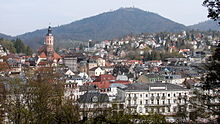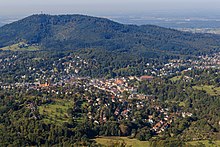Baden-Baden
![]()
The title of this article is ambiguous. For other meanings, see Baden-Baden (disambiguation).
Baden-Baden ( ![]() ) is a city in western Baden-Württemberg and the least populous urban district in the state. It is known as a spa and bath city as well as a media, art and international festival city. The Romans already used the hot thermal springs that rise here on the edge of the Black Forest. In the Middle Ages, Baden-Baden was the seat of the Margraviate of Baden and thus also gave its name to the state of Baden. After the catastrophic town fire in 1689, it lost the status of residential town to Rastatt.
) is a city in western Baden-Württemberg and the least populous urban district in the state. It is known as a spa and bath city as well as a media, art and international festival city. The Romans already used the hot thermal springs that rise here on the edge of the Black Forest. In the Middle Ages, Baden-Baden was the seat of the Margraviate of Baden and thus also gave its name to the state of Baden. After the catastrophic town fire in 1689, it lost the status of residential town to Rastatt.
In the 19th century, the spa town was rediscovered and developed into an internationally significant meeting place for aristocrats and wealthy citizens, also thanks to the income from the casino. A rich, well-preserved material and immaterial heritage has been preserved from this 19th century heyday.
Name History
The Roman settlement, like many cities with healing springs, was called Aquae, the Latin word for spring or bath. While no epithet is known for the town itself, the administrative district surrounding it bore the honorary title Civitas Aurelia Aquensis in the 3rd century. This has been associated by many authors with Emperor Caracalla ('Marcus Aurelius Severus Antoninus'), who had the baths developed. According to a more recent theory, Emperor Elagabal ('Marcus Aurelius Antoninus') was the eponym.
Since the Middle Ages, the town was simply called Baden. The place name also passed to Hohenbaden Castle, built around 1100, the new seat of power of Hermann II, originally Margrave of Verona. In the course of the 12th century Baden became part of his title; the Margraviate of Baden was created, which was divided into two parts from the 16th to the 18th century and rose to become the Grand Duchy in the 19th century. Thus, the name of the state of Baden, and thus that of today's Baden-Württemberg, has an origin in the name of the city of Baden(-Baden).
To distinguish from towns of the same name - Baden in Switzerland and Baden near Vienna, also Badenweiler in the old Baden Oberland was originally only called Baden - an addition was often necessary. Thus the city was also called Niederbaden, Markgrafen-Baden and later Baden in Baden. The name Baden-Baden initially stood for the Catholic margraviate Baden-Durlach, which was separated from its Protestant counterpart from 1535 onwards (meaning something like "margraviate Baden, residence Baden"). After the Catholic margraves moved their seat to Rastatt in the 18th century, Baden bei Rastatt became common as the name of the town of Baden. When the Catholic line died out in 1771 and the Margraviate of Baden - now with Karlsruhe as its residence - reunited, Rastatt receded into the background. The name Baden-Baden passed from the former territory to the city of Baden, whose importance had grown again in the 19th century. The double name prevailed long before it became official on 1 September 1931.
Geography
Location
The city district of Baden-Baden is surrounded by the district of Rastatt. Baden-Baden lies on the western edge of the northern Black Forest in the valley of the Oos, a small river that flows into the Murg about 13 km further on near Rastatt. The eastern parts of the town partly nestle into the slopes of the Black Forest. The highest point of the city area is the Badener Höhe at 1002 m. The western parts of the town lie in the Vorberg zone and the Upper Rhine lowlands, where the lowest point of the district, at 112 m, is in the Geggenau in the Rastatter Ried nature reserve. Vineyards are cultivated in the Vorberg zone. The Baden-Badener Rebland belongs to the wine-growing region Ortenau.
Regional importance
With a population of around 54,000, Baden-Baden is the smallest of the state's nine independent cities and forms a medium-sized centre with partial functions of a regional centre. In addition to the city of Baden-Baden, the municipalities of Hügelsheim and Sinzheim, both of which are located in the Rastatt district, also belong to the Baden-Baden central area. Furthermore, there are relations with the French North Alsace.
City breakdown
→ Main article: List of places in Baden-Baden
The city of Baden-Baden is divided into the following districts: Oos, Balg, Weststadt, Innenstadt, Lichtental with Oberbeuern and Geroldsau, Ebersteinburg, Steinbach, Neuweier, Varnhalt, Haueneberstein and Sandweier.
In addition, there are numerous other residential places or residential areas with their own name, some of which are very scattered: Gaisbach, Gallenbach (Varnhalt), Hungerberg, Malschbach, Mührich, Müllenbach, Schmalbach, Schneckenbach (Neuweier), Seelach, Umweg (Steinbach) and Unterer Plättig.
The districts of Ebersteinburg, Haueneberstein and Sandweier each have their own local administration with a local head. The districts of Steinbach, Neuweier and Varnhalt have a joint local administration (Rebland), also with a local chairman.
In the city district of Baden-Baden there are three uninhabited exclaves of the neighbouring municipality of Sinzheim, including the Fremersberg monastery estate.
Neighbouring municipalities
The following towns and communities border the city of Baden-Baden. They are named clockwise, starting in the north, and all belong to the district of Rastatt: Rastatt, Kuppenheim, Gaggenau, Gernsbach, Weisenbach, Forbach, Bühl, Bühlertal, Sinzheim, Hügelsheim and Iffezheim.
Floor space allocation

According to data from the State Statistical Office, as of 2017.
With 85.26 km² or 60.8 percent of the city area (state average for Baden-Württemberg: 37.8 %), an above-average proportion of the area is covered with forest. Of this, approx. 75 km² are in municipal ownership, making Baden-Baden's municipal forest one of the largest in Germany.
Protected areas
In the area between Badener Höhe and Schwarzwaldhochstraße, Baden-Baden has a share in the Black Forest National Park. Seven nature reserves lie wholly or partly within the town's boundaries. More than 60 percent of the municipal area is under landscape protection. The Geroldsau Waterfall and the Wolfsschlucht (Wolf Gorge) are among the six extensive natural monuments in Baden-Baden. Dozens of individual trees in the gardens, parks and forests are protected as natural monuments.
See also: List of nature reserves in Baden-Baden, List of landscape conservation areas in Baden-Baden and List of natural monuments in Baden-Baden

Rebland: Neuweier and the Yberg

Baden-Baden and the Mercury from the Kurpark

View of Baden-Baden and the Fremersberg from Merkur
Questions and Answers
Q: What is Baden-Baden?
A: Baden-Baden is a spa town located in Baden-Württemberg, Germany with around 50,000 inhabitants.
Q: Where is Baden-Baden located?
A: Baden-Baden is located at the border of the Rhine valley and the Black Forest.
Q: What is Baden-Baden well known for?
A: Baden-Baden is well known as a spa town, as a place for rich people, and for many cultural offers.
Q: What role did the town of Baden-Baden play in the 19th century?
A: In the 19th century, Baden-Baden played an important role as a meeting place for the nobles, rich, and other important people.
Q: What can still be found in Baden-Baden from the 19th century?
A: A rich cultural heritage from the 19th century can still be found in Baden-Baden.
Q: What language is spoken in Baden-Baden?
A: The Alemannic German language is spoken in Baden-Baden.
Q: What country is Baden-Baden located in?
A: Baden-Baden is located in Germany.
Search within the encyclopedia